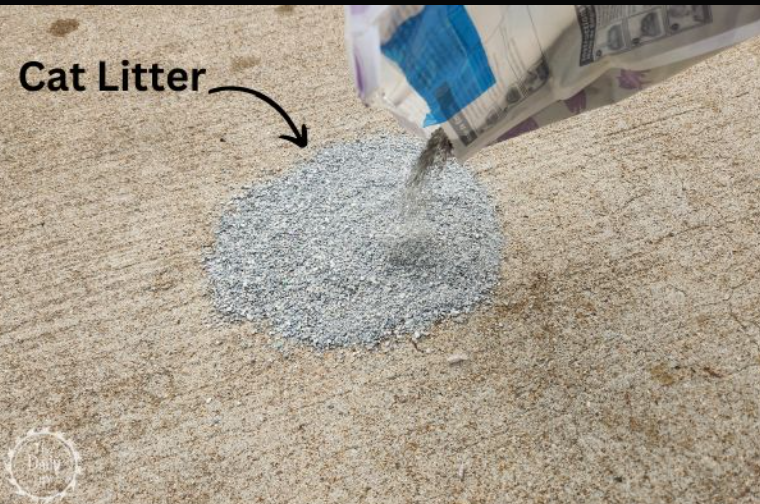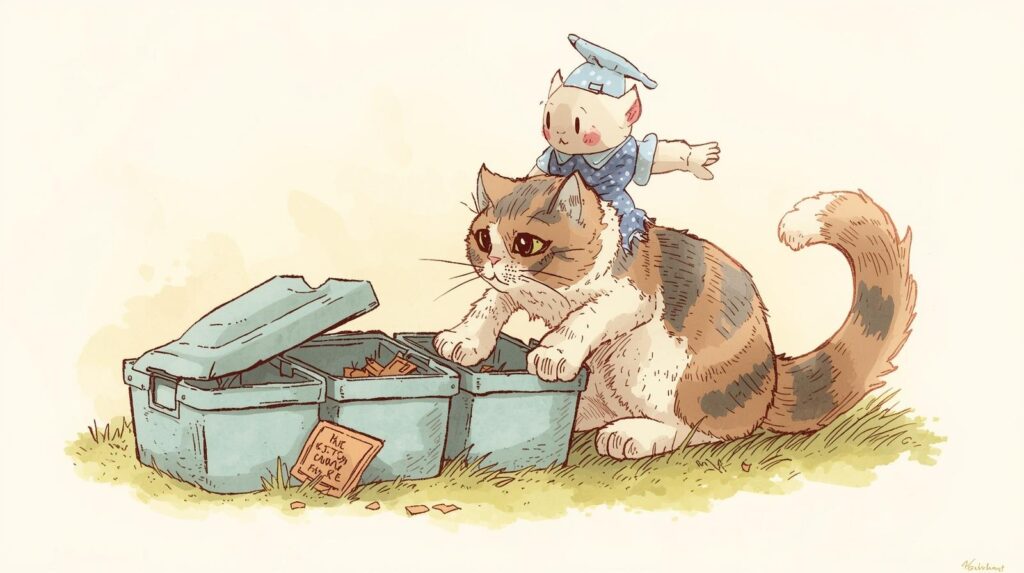Spilled oil on the garage floor or driveway? Don’t worry—you’re not the only one. It happens to all of us, whether it’s from a car, a lawnmower, or a clumsy kitchen moment. If you’re reaching for a quick solution and wondering, “Wait… can I use cat litter for this?” — you’re in the right place.
The short answer is yes, certain types of cat litter can absorb oil. But before you dump a scoop of whatever’s in the litter box, there are a few important things to know. Not all cat litter works the same way, and using it the right way makes all the difference.
In this guide, we’ll walk you through why people use cat litter for oil spills, how it works, what types work best, and exactly how to use it to clean up those messy spots.

Table of Contents
2. Why People Use Cat Litter for Oil Spills
Oil stains can be tough. Whether it’s a fresh spill in the garage or an old greasy patch on your driveway, cleaning oil off concrete or pavement isn’t easy. That’s why many people turn to cat litter—it’s cheap, easy to find, and surprisingly effective in the right situation.
Here’s why it’s a popular DIY fix:
- You probably already have it at home, especially if you have cats.
- It soaks up oil better than paper towels or rags.
- It’s often used by mechanics and car enthusiasts for exactly this reason.
While it may not be a perfect substitute for professional oil-absorbent products, cat litter can be a solid quick fix for small-to-medium spills—if you use the right kind.
3. How Cat Litter Works as an Absorbent
So, how does cat litter actually absorb oil?
The magic is in its structure. Most traditional cat litter is made from clay, which is highly porous. That means it’s full of tiny holes that can soak up liquids—kind of like a sponge but made of dirt.
When you pour cat litter over an oil spill, those little granules start pulling in the oil. The litter traps the oil in its pores, helping to dry out the spill and prevent it from spreading.
However, it’s important to note that cat litter doesn’t chemically break down the oil; it merely soaks it up, making it easier to clean.
This absorption capability is why bentonite clay is also used in industrial applications, such as cleaning up hazardous spills and in products like Fuller’s earth
Keep in mind: cat litter is primarily designed to absorb moisture (like urine), not oil. So while it works, it’s not as efficient or fast as some commercial oil-absorbing materials. But for small jobs? It does the trick.
4. Types of Cat Litter and Their Effectiveness on Oil
Not all cat litter is created equal—especially when it comes to oil spills. Here’s a breakdown of how different types perform:
✅ Clay-Based (Non-Clumping) Cat Litter
- Best choice for oil absorption
- Coarse and porous—great for soaking up oil
- Often used in garages and auto shops
- Cheap and easy to find
⚠️ Clumping Cat Litter
- Designed to clump with moisture, not oil
- Can turn into a sticky mess with oil
- Not recommended
🚫 Silica Gel Litter
- Made of crystals that absorb water, not oil
- Ineffective on oily surfaces
🌱 Biodegradable Litters (Pine, Corn, Wheat, etc.)
- Eco-friendly, but not very effective at absorbing oil
- Better suited for composting than cleanup
If you’re dealing with a greasy spill, go for the classic clay litter—the chunkier and more absorbent, the better.
5. Step-by-Step Guide: How to Use Cat Litter to Absorb Oil
Ready to tackle that spill? Here’s how to do it like a pro.
What You’ll Need:
- Non-clumping clay cat litter
- Gloves (optional, but a good idea)
- Broom and dustpan
- Trash bag
- Optional: stiff brush or detergent for stains
Step-by-Step Instructions:
- Pour litter directly onto the oil spill
Cover the area generously. You want a thick layer, not just a sprinkle. - Let it sit and absorb
The longer it sits, the more oil it will pull up. 12–24 hours is ideal, but even an hour or two helps. - Crush it slightly (optional)
Step on it gently to break it up a bit and help it absorb more oil—just don’t grind it in. - Sweep it up
Once it’s had time to absorb the oil, sweep it into a dustpan and dispose of it properly. - Clean the Residue: If a stain remains, scrub the area with a bristle brush and a degreasing detergent, then rinse with water.
That’s it! With just a little effort, you’ll have a cleaner surface and one less thing to worry about.
6. Pros and Cons of Using Cat Litter for Oil
Like any DIY hack, using cat litter to absorb oil has its ups and downs. Here’s what to keep in mind:
✅ Pros
- Affordable: Much cheaper than commercial oil absorbers.
- Easily available: Found at any grocery, pet, or convenience store.
- Surprisingly effective: Especially for fresh spills on concrete, asphalt, or even garage floors.
- Multi-use: If you have cats, you already have it at home.
❌ Cons
- Not a perfect cleaner: It absorbs oil but doesn’t always remove the stain completely.
- Messy cleanup: Can be dusty, especially if you’re dealing with a large spill.
- Not eco-friendly (for traditional clay litters): Most are made from strip-mined bentonite clay.
- Disposal concerns: Oil-soaked litter needs to be thrown away carefully (more on that below).
It’s a solid option for quick fixes, but if you’re handling frequent or large-scale spills, you might want to consider something made specifically for oil cleanup.
7. Environmental Considerations
Before you toss that oil-soaked cat litter in the trash, there are a few things you need to consider—for your safety and the planet’s.
Disposing of Oil-Soaked Litter
- Check with your local waste disposal service. Some places treat oil-soaked materials as hazardous waste.
- Never burn used litter with oil—it’s flammable and releases toxic fumes.
- If allowed in your area, double-bag the litter and throw it out with your regular trash.
Environmentally Friendly Options
- Use biodegradable litter (like pine or corn) if you want a more eco-friendly approach—though it won’t absorb as much oil.
- For heavy-duty eco cleanup, look into products like SpillFix (made from coconut husks).
Always follow local regulations when disposing of anything involving oil. What’s okay in one city might be banned in another.
8. Limitations and Safety Considerations
While cat litter is effective for small-scale oil spills, it has limitations:
- Surface-Level Absorption: Cat litter absorbs oil on the surface but may not penetrate deeply into porous materials like concrete, or if the oil is too much. Some people use cat litter as an oil absorbent, but it wasn’t a success. Like this person on Reddit, he used litter to remove oil, but the oil was excessive, and the mission failed

- Health Hazards: Some cat litters contain crystalline silica, which can be hazardous when inhaled. Always use in well-ventilated areas and consider wearing a mask.
- Not Ideal for Large Spills: For significant oil spills, especially in industrial settings, specialized absorbents are more effective.
9. Alternatives to Cat Litter for Oil Absorption
If you don’t have cat litter on hand—or if you want a better or cleaner solution—here are some other options to consider:
Commercial Absorbents
- Oil-Dri, SpillFix, or Zep Oil Absorber
- Designed specifically for garages, auto shops, and industrial use
- Clean and highly effective, but pricier
Household Alternatives
- Baking soda: Works for very small spills or greasy stovetops
- Sawdust or wood shavings: Great for workshop areas
- Sand: Not very absorbent, but helps contain and weigh down oil
- Paper towels or rags: For tiny spills, not ideal for soaking
If you want a long-term, low-effort solution for oil cleanup, investing in a good oil absorbent may be worth it. But for one-off accidents? Cat litter still holds up.
11. Common Questions (FAQs)
Can I use cat litter on engine oil spills?
Yes. Clay-based cat litter is very effective on engine oil spills—whether it’s under your car or on your garage floor.
Will cat litter remove old oil stains from concrete?
It helps, especially if the stain is recent. For older stains, you might need to repeat the process or use a degreaser afterward.
How long should I leave cat litter on an oil spill?
For best results, leave it for at least 12 to 24 hours. Even 1–2 hours will help with smaller spills.
Does scented or unscented cat litter make a difference?
Not really for oil cleanup. Just make sure it’s non-clumping and clay-based—that’s what matters most.
Can I reuse cat litter after absorbing oil?
No. Once it’s soaked up oil, it’s contaminated. Always throw it away after use.
10. Final Thoughts
So, does cat litter absorb oil? Yes—it definitely can.
If you’re looking for a quick, affordable way to clean up oil from concrete, driveways, or garage floors, non-clumping clay cat litter is a surprisingly effective solution. It won’t remove deep stains entirely, but it will soak up fresh oil, make cleanup easier, and prevent damage or slips.
For the best results:
- Stick to basic, unscented clay litter
- Let it sit for 12–24 hours
- Sweep and dispose of it safely
Whether you’re cleaning up after your car or a cooking accident, cat litter might just be the tool you didn’t know you needed.


